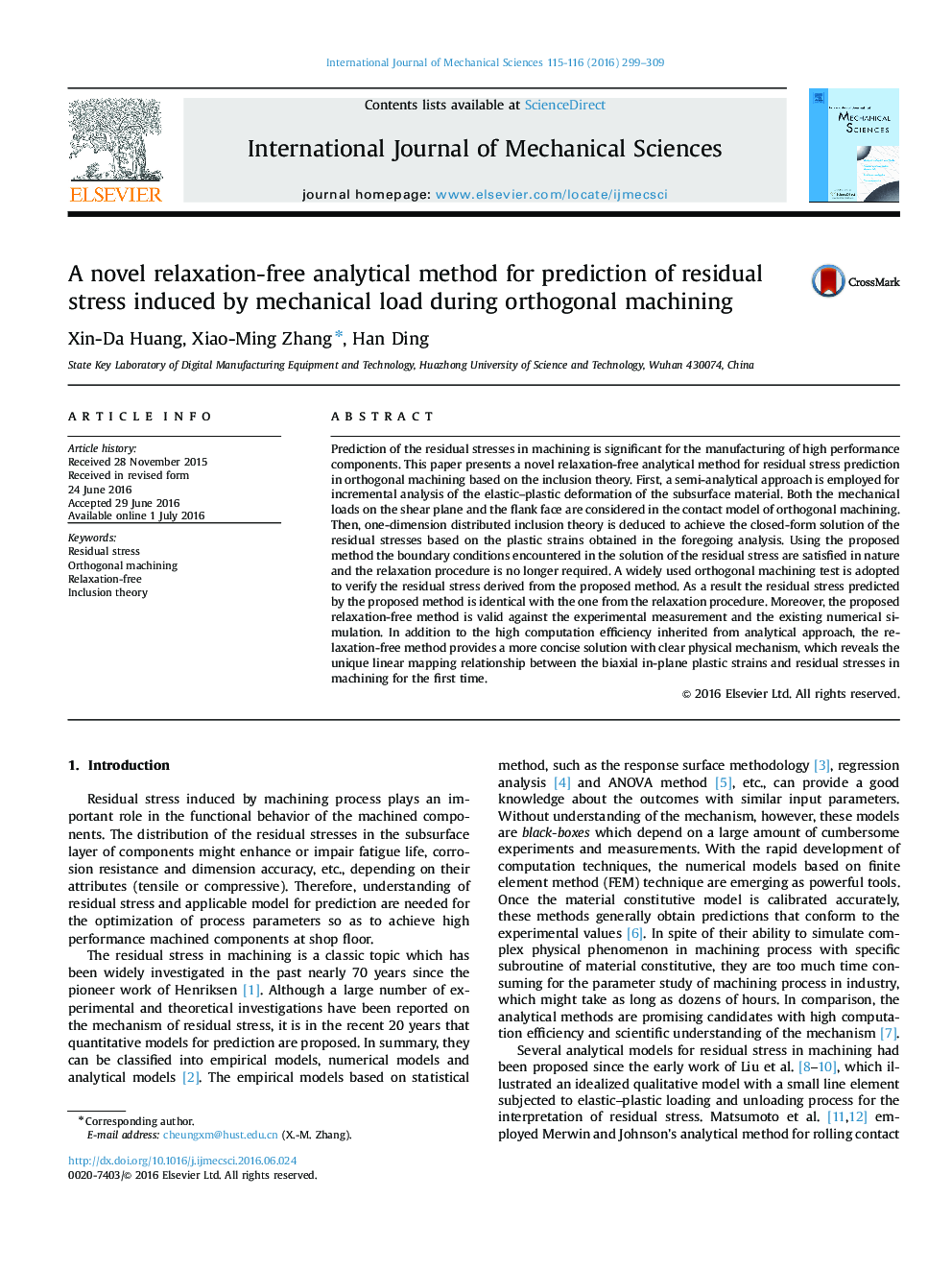| کد مقاله | کد نشریه | سال انتشار | مقاله انگلیسی | نسخه تمام متن |
|---|---|---|---|---|
| 779962 | 1464970 | 2016 | 11 صفحه PDF | دانلود رایگان |
عنوان انگلیسی مقاله ISI
A novel relaxation-free analytical method for prediction of residual stress induced by mechanical load during orthogonal machining
ترجمه فارسی عنوان
یک روش تحلیل تحلیلی جدید برای پیش بینی ولتاژ باقی مانده ناشی از بار مکانیکی در هنگام ماشینکاری مجدد
دانلود مقاله + سفارش ترجمه
دانلود مقاله ISI انگلیسی
رایگان برای ایرانیان
کلمات کلیدی
استرس باقی مانده، ماشینکاری مجدد، بدون آرامش نظریه ورودی،
ترجمه چکیده
پیش بینی تنش های باقی مانده در ماشینکاری برای تولید اجزای عملکرد بالا قابل توجه است. این مقاله یک روش تحلیلی جدید برای آرامش بخش برای پیش بینی استرس باقی مانده در ماشینکاری متعامد بر اساس نظریه ورودی ارائه می دهد. ابتدا یک رویکرد نیمه تحلیلی برای تحلیل افزایشی تغییر شکل کششی پلاستیک مواد زیرزمانی استفاده می شود. هر دو بارهای مکانیکی بر روی سطح برش و چهره جانبی در مدل تماس با ماشینکاری مجدد در نظر گرفته شده است. سپس یک تئوری توزیع توزیع توزیع به دست می آید تا راه حل بستۀ تنش های باقی مانده را بر اساس سودهای پلاستیکی حاصل از تجزیه و تحلیل های پیشین بدست آورد. با استفاده از روش پیشنهادی، شرایط مرزی مواجه شده در راه حل تنش باقی مانده در طبیعت رضایت بخش هستند و روش آرام سازی دیگر لازم نیست. برای بررسی تنش باقی مانده مشتق شده از روش پیشنهادی، یک تست تصادفی متعامد به طور گسترده ای استفاده می شود. در نتیجه تنش باقی مانده توسط روش پیشنهادی با یک روش از آرامش یکسان است. علاوه بر این، روش آرامش بخش پیشنهاد شده در برابر اندازه گیری تجربی و شبیه سازی عددی موجود معتبر است. علاوه بر کارایی محاسباتی بالا که از رویکرد تحلیلی به ارث برده شده است، روش بدون آرامش، یک راه حل مختصر را با مکانیسم فیزیکی واضح فراهم می کند که نشان می دهد که رابطه ی نقشه یابی خطی منحصر به فرد بین دو شاخه ی پلاستیکی درون هواپیما و تنش های باقی مانده در ماشینکاری برای اولین بار زمان.
موضوعات مرتبط
مهندسی و علوم پایه
سایر رشته های مهندسی
مهندسی مکانیک
چکیده انگلیسی
Prediction of the residual stresses in machining is significant for the manufacturing of high performance components. This paper presents a novel relaxation-free analytical method for residual stress prediction in orthogonal machining based on the inclusion theory. First, a semi-analytical approach is employed for incremental analysis of the elastic-plastic deformation of the subsurface material. Both the mechanical loads on the shear plane and the flank face are considered in the contact model of orthogonal machining. Then, one-dimension distributed inclusion theory is deduced to achieve the closed-form solution of the residual stresses based on the plastic strains obtained in the foregoing analysis. Using the proposed method the boundary conditions encountered in the solution of the residual stress are satisfied in nature and the relaxation procedure is no longer required. A widely used orthogonal machining test is adopted to verify the residual stress derived from the proposed method. As a result the residual stress predicted by the proposed method is identical with the one from the relaxation procedure. Moreover, the proposed relaxation-free method is valid against the experimental measurement and the existing numerical simulation. In addition to the high computation efficiency inherited from analytical approach, the relaxation-free method provides a more concise solution with clear physical mechanism, which reveals the unique linear mapping relationship between the biaxial in-plane plastic strains and residual stresses in machining for the first time.
ناشر
Database: Elsevier - ScienceDirect (ساینس دایرکت)
Journal: International Journal of Mechanical Sciences - Volumes 115â116, September 2016, Pages 299-309
Journal: International Journal of Mechanical Sciences - Volumes 115â116, September 2016, Pages 299-309
نویسندگان
Xin-Da Huang, Xiao-Ming Zhang, Han Ding,
